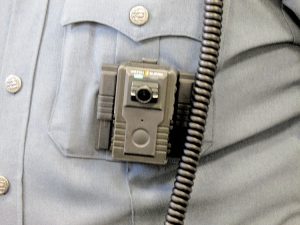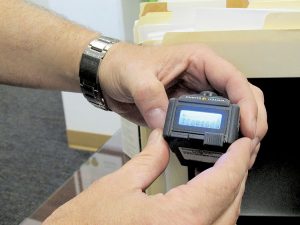By John Burton |
ATLANTIC HIGHLANDS — Police Chief Jerry Vasto told a story about a traffic stop he had while on duty a couple of years ago. It was routine, he said, and he wound up giving the young male driver a simple warning. But what made it interesting to Vasto, was that the young woman sitting in the front passenger seat had slipped out her cell phone and video recorded the interchange. When he was done, after giving the driver a little lecture on safe driving, Vasto told the driver if he had any questions he could review his girlfriend’s video. And that surprised and flustered the girl who didn’t realize the officer had noticed.
“Now, no surprises,” Vasto said, as officers inform the public during all stops that they’re now subject to being video recorded.
Atlantic Highlands is the latest department in Monmouth County to adopt body worn cameras for patrol officers. Thanks to a matching grant made available from the state Office of the Attorney General, funds were made available to county prosecutors for local law enforcement camera purchases. The state funds were used by way of the Criminal Forfeiture Fund, with the state allocating $2.5 million for local departments
The Atlantic Highlands department with its $3,500 and matching $3,500 was able to purchase seven cameras and accompanying equipment. The department has been using them for about two weeks at this point. “So, it’s a little new yet, so not much to report,” Vasto acknowledged. “But I’m really curious to see how it pans out.”
According to the Monmouth County Prosecutor’s Office, there are more than 400 body worn cameras being used, or being prepared to used, by law enforcement in the county. Along with the county Sheriff’s Office, departments that have begun using them or in the process of establishing a program are: Asbury Park, Atlantic Highlands, Bradley Beach, Englishtown, Highlands, Howell, Long Branch, Manalapan, Marlboro, Middletown, Monmouth Beach, Neptune City, Ocean, Sea Bright, Sea Girt, Spring Lake Heights, Union Beach and Wall.
The cameras themselves are about the size of the average smartphone and can be attached to the officer’s uniform. Typically they are located in the chest or shoulder area to give the best point of view.
When it was first announced that the department would begin using them, “There was a little resistance, like anything new,” from some of the 13-officer department, Vasto acknowledged. But, Vasto, who has been with the department for 40 years, recalled that was the case when the department first instituted in-vehicle cameras in the 1990s (back when they used VHS cassettes). “But as time goes on they realize it’s part of the job to have something like this.”
“Across the country, we’ve seen what happens when distrust and distance between police and their communities result in situations that can quickly spiral out of control,” said Gov. Chris Christie in a released statement when announcing the grant program in 2015, referencing the long stream of citizen-made videos of confrontations between law enforcement and the public. “In New Jersey we’re doing things differently and showing how engagement and relationship-building by officers in their communities make our neighborhoods safer and our law enforcement efforts more effective.

Departments using the equipment have to adhere to the attorney general’s protocol established two years ago. That directive lays out the parameters for using the body worn cameras for traffic stops and other calls, plus interrogations, witness interviews, deadly force incidents and on-scene investigations. But the guidelines also allow for times when the cameras can be deactivated, such as when police enter schools, houses of worship, hospitals, private homes, unless on an emergency or crime call, or are dealing with an uncover officer or confidential informant. The directive includes provisions to protect children and crime victims.
Police have to inform the public they are being recorded; officers can turn it off at their discretion but it has to be documented and officers can’t make the suggestion that it be deactivated, explained Atlantic Highlands Police Sgt. Harry B. Murtha III.
The camera offers protection to department members as well as the public, police officials believe. “In a sense, it probably backs up the officer more, depending on whatever occurs,” Vasto said.
“Basically, what you’re getting is you can recall the entire (police) call,” to get a more accurate sense of the incident, said Atlantic Highlands David Rossbach, a 32-year veteran with the department.
“It makes people realize they were on video so they were acting better,” contributed Monmouth Beach Police Chief Thomas Walsh. “On both sides.”
“I’m all for them,” Walsh said, planning on instituting a pilot program for his small department for the summer. “It serves its purpose to give a clear account of what happened but also protecting victims of crime,
“It’s a tightrope act,” to maintain that balance, he offered. “But I’m sure it can be done successfully.”

There are issues with adopting this program, however, law enforcement conceded: namely the logistics of operating new technical equipment, especially away from the patrol scenario.
“The backend issues will be the big challenge,” observed Middletown Deputy Police Chief Robert Stefanski. By “backend” he means the administrative end, especially data storage. Middletown has a 112-member department. “That’s a lot of data to store,” Stefanski admitted, explaining using cloud storage or outsourcing the responsibility to a private sector company can be expensive.
Middletown has the equipment, which it too obtained with the state grant, and is in the process of establishing the program. which Stefanski predicts the program could be in place within the next six months to a year, depending on working out some administrative details.
“It’s not a cure-all,” Stefanski said. “But it gives the public a little bit more insight into what officers are looking at.”
However, there still remains issues of public access and logistics of redacting non-public information and local law enforcement is still working to get a grip on those parameters.
“It’s still a grey area,” Murtha acknowledged.
This article was first published in the May 4-11, 2017 print edition of The Two River Times.














